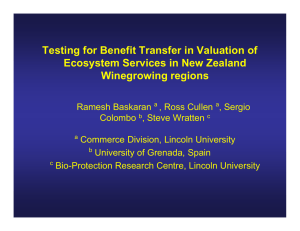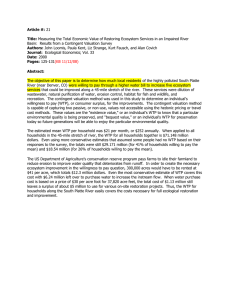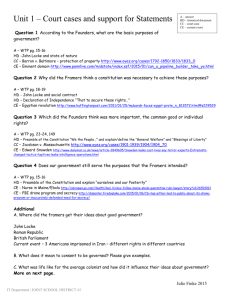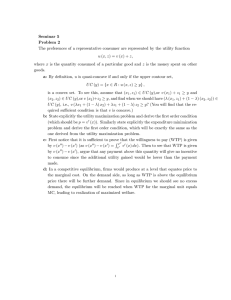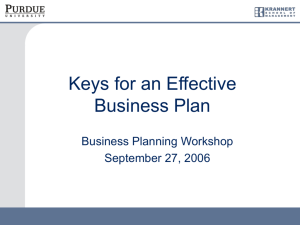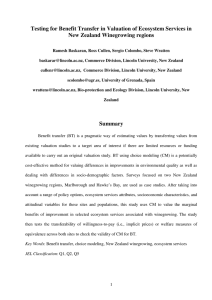Testing Different Types of Benefit Transfer in Winegrowing Case Studies
advertisement
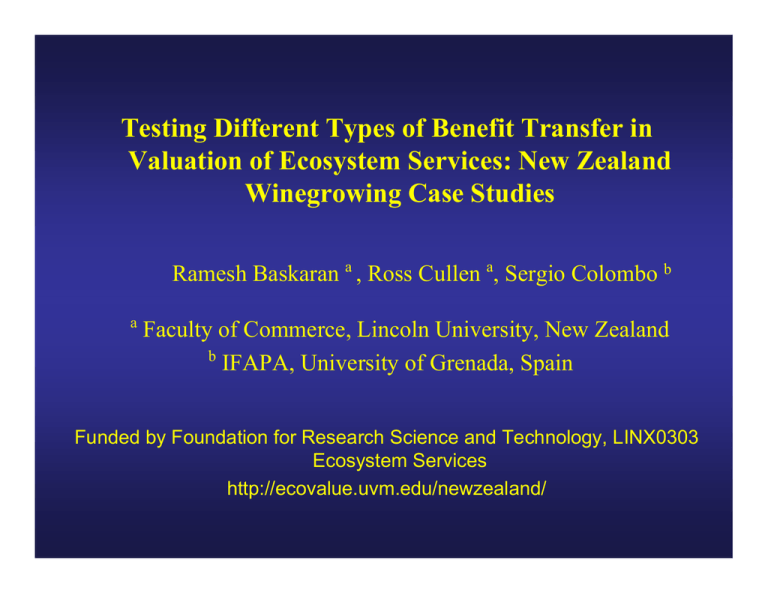
Testing Different Types of Benefit Transfer in Valuation of Ecosystem Services: New Zealand Winegrowing Case Studies Ramesh Baskaran a , Ross Cullen a, Sergio Colombo b a Faculty of Commerce, Lincoln University, New Zealand b IFAPA, University of Grenada, Spain Funded by Foundation for Research Science and Technology, LINX0303 Ecosystem Services http://ecovalue.uvm.edu/newzealand/ Marlborough & Hawke’s Bay Winegrowing Regions Hawke’s Bay Marlborough Overview of the presentation • • • • • • Problem Statement Objectives of the study Methods Results Policy Implications Conclusion Problem Statement • Adverse environmental impacts on Ecosystem Services (ES) from intensification of winegrowing production • Excessive levels of residues in wine from fungicides, pesticides and herbicides – Consumer concerns and food safety regulations • High risk of toxic chemical (e.g., fungicides and pesticides) reaching groundwater – Exceed maximum recommended levels • Greenhouse gas emission – 3 tonnes of CO2 equivalent hectare-1year-1 are emitted – Close to the average emissions hectare-1for all NZ agriculture • Removal of indigenous biodiversity – NZ developed landscapes have lost most of their native biodiversity (e.g., plants, habitats and wildlife) Objectives of the Study • Estimate the average Willingness-to-Pay (WTP) of Marlborough and Hawke’s Bay households for improving the environmental impact caused by winegrowing practices • Using the estimated WTP values for Benefit Transfer (BT) analysis – Examine the validity of BT – Whether it is feasible to conduct the transfer process and assist policy making Methods • Choice Modeling (CM) Method – Random Parameter Logit (RPL) Model • Explicitly considers taste variation among individuals (e.g., heterogeneity preferences) • Benefit Transfer (BT) – Marginal Value Transfer (e.g., unadjusted mean WTP) – Function Transfer (e.g., unadjusted Compensating Surplus (CS)) • BT Validity Tests 1. Testing if the Model Parameters are Equivalent 2. Testing if the Mean WTP and CS are Equivalent 3. Testing if the Mean WTP and CS are Transferable Winegrowing CM Attributes 1. Residue in wine • Current, organic and zero levels 2. Risk of toxic chemicals reaching groundwater • High, low and no risk levels 3. Greenhouse gas emission per hectare per year • Current, 30% reduction and zero net levels 4. Native wildlife populations • Current, 10% increase and 30% increase 5. Cost to household per year for next 5 years • NZ$0, $15, $30, $45, $60, $75, $90 Example of Choice Set Attributes Alternative 1 Alternative 2 Status Quo Fewer residues with organic Zero residues No change No Low High GHG emissions hectare-1year-1 Zero net 30% reduction No change Native wildlife populations 30% increase 10% increase No change $45 $15 $0 Residues in wine Risk of toxic chemicals reaching groundwater Cost ($ per year for the next 5 years) Types of Benefit Transfer Tests Hawke’s Bay Site Marlborough Site A D C B Hawke’s Bay Population Marlborough Population E F Geographically Separated Type 1: Differences across populations only (B vs D and A vs C) Type 2: Differences across sites only (A vs B and C vs D) Type 3: Differences across sites and equivalent populations but geographic separation (A vs D, D vs F, and A vs E) Type 4: Differences across sites and different populations (B vs C) Data Collection – D-efficient fractional factorial design using Street et al. (2005) procedure created 18 choice sets • 6 choice sets with 3 sub-version questionnaires – 4392 respondents randomly selected from NZ electoral roll for Marlborough and Hawke’s Bay regions. Data Collection – Sample was divided into 4 strata • Marlborough population valuing ES in their own region (MARL) • Marlborough population valuing ES in Hawke’s Bay region (MARLPOP) • Hawke’s Bay population valuing ES in their own region (HB) • Hawke’s Bay population valuing ES in Marlborough region (HBPOP) Data Collection – Survey questionnaires were sent to both regions in April 2008 – 1098 respondents selected for each sample – Total effective response rate • 30% - MARL • 20% - HB • 18% - HBPOP • 24% - MARLPOP – Choice data • analyzed using NLOGIT 4.0 CM Results • On average, respondents are willing to pay more for increases in the quality and/or quantity of each attribute regardless of their residency • WTP for reduced chemical residues in organically produced wine (RESORG) is not significant for all samples • Risks of contamination in groundwater quality for all samples - highly valued - most important attribute CM Results • Values for MARL sample are higher compared to other samples Marlborough region Hawke’s Bay region -largest wine growing region - rapid expansion of vineyards - nuisance and concerns to residents - oldest winegrowing region - experiencing slower growth - vineyards are more dispersed - impact on ES may be less intensive CM Results Mean WTP HB < Mean WTP HBPOP Scale effect in Marlborough region - size of the region and the intensity of Mean WTP MARL < Mean WTP MARLPOP the issues in that area Mean annual CS estimates per household associated with different policy options Attribute Current Policy 1 Policy 2 Policy 3 Policy 4 0 0 0 0 Organic Low risk 30% 10% Zero No risk Zero 30% Organic Low risk 30% 0 Zero No risk 0 0 HB CS ($) 147.35 164.69 136.81 108.41 HBPOP CS ($) 156.17 175.13 134.87 104.88 MARL CS ($) 287.54 317.44 232.41 193.03 MARLPOP CS ($) 227.90 235.04 203.30 174.94 POOLED CS ($) 191.76 207.48 162.27 131.21 Wine residue Water quality GHG reduction Biodiversity increase • • On average, respondents are willing to pay more for higher levels of improvement Indicate the importance of attribute tradeoffs – Policy 1 and Policy 3 shows biodiversity effect – reduces WTP by 12% – Policy 2 and Policy 4 trading offs GHG and biodiversity – reduces WTP by 34% BT Results 1. Testing if the Model Parameters are Equivalent • Swait and Louviere (1993) grid search technique • All the BT types rejected the null hypothesis (i.e., significant differences exist between the two sites) – – • the two model parameters are different BT is invalid Only POOL & MARL and POOL & MARLPOP samples have no significant differences – BT is valid BT Results 2. Testing if the Mean WTP and CS are Equivalent • Poe et al. (2005) – complete combinatorial method • HB & HBPOP • POOL & HBPOP • POOL & MARLPOP • Kristofersson and Navrud (2005) - suggest possibility of Type II Error null hypothesis Do not reject the null hypothesis (i.e., no significant differences exist between the sites) Marginal value (WTP) and benefit function (CS) are equivalent – BT is valid (i.e., of failing to reject the H0 that WTP are the same when it is false) - suggest incorporating tolerance limit when testing for welfare measure BT Results 3. Testing if the Mean WTP and CS are Transferable • Johnston and Duke (2008) proposed an alternative equivalence test for non-normal welfare distributions • Called the two one-sided convolutions test – TOSC • It incorporates both Poe et al. (2005) and Kristofersson and Navrud (2005) • Two different tolerance limits (TL) – 50% and 80% are used at α = 0.10 level • If TL is increased to 80%, more WTP and CS values can be transferred across sites and populations. BT Results 3. Testing if the Mean WTP and CS are Transferable (Cont.) Example : If the policymaker is willing to tolerate a 50 % difference between the WTP at HB & MARL samples Failure to reject the H0 - WTPs are not equivalent Transfer is invalid between HB and MARL Summary of BT Results • The validity tests show mixed results – did not demonstrate strong plausibility of transferring the estimated values Example: The Equivalent Test for Model Parameters opposed the benefit function transfer In contrast, the Equivalent Test for WTP suggested otherwise • Statistically, BT is not a reliable approach for transferring the winegrowing ES benefits generated using CM Summary of BT Results (Cont.) • • Despite controlling factors that can affect the accuracy of BT – survey instrument – model specifications – valuing the same resource change – time period – similar demographic profile Difficult to select either one of them as the “study” site to transfer values Policy Implications • Successful application of BT methods remains a challenge • The three tests performed to validate BT – not able to convince the policymakers about the merit of BT • Acceptable levels of transfer error depends on the analyst‘s experience and professional judgment – – – How expensive would it be to conduct a new study? What level of error would the values from a new study have? How critical is preciseness of the attribute values to the analyst? • Be cautious when applying BT approach • Wrong policy decision may lead to large welfare loss and misallocation of resources Conclusion • Respondents value programs that result in significant: – – – – Total reduction in toxic chemical residue content in wine Reduction in risks of toxic chemicals reaching groundwater Reduction in greenhouse gas emissions Increase in natural and native biodiversity • Validity tests provide conflicting results of whether to follow the transfer process • Further research in the development of conventional BT approach is needed • BT depends on the professional judgment of the analyst – need to consider tradeoff between the risks of 1. 2. 3. Under/over-estimated WTP values Saving in time and money/resources of conducting a new study Making costly policy decision mistakes

